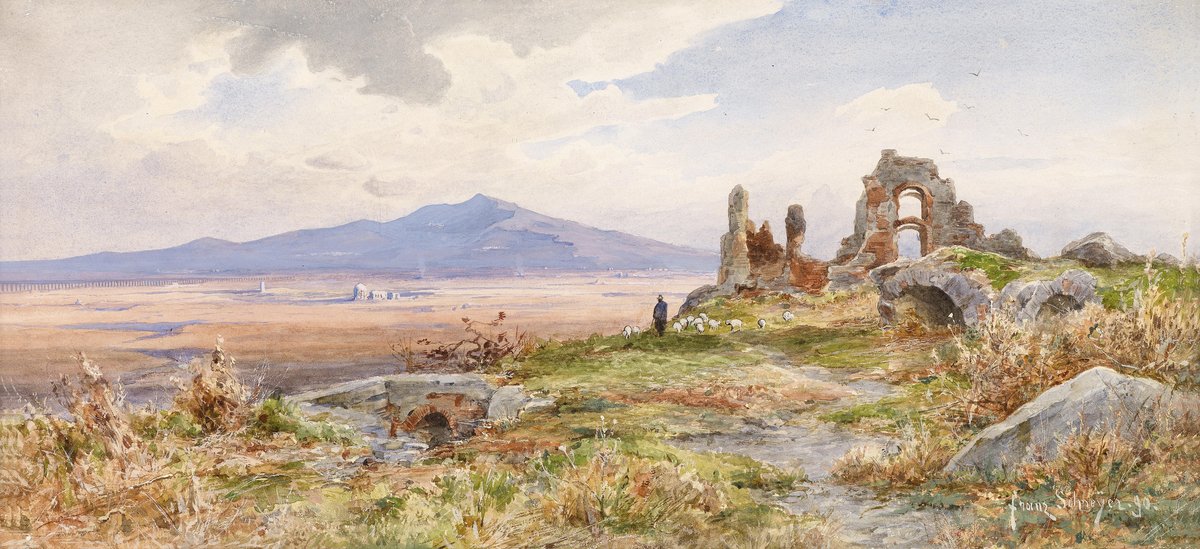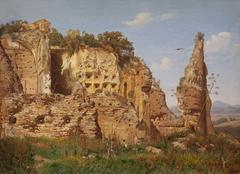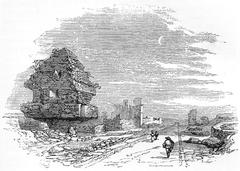
Villa of the Quintilii: Complete Guide to Visiting Hours, Tickets, History, and Tips
Date: 14/06/2025
Introduction
The Villa of the Quintilii (Villa dei Quintili), set along Rome’s legendary Via Appia Antica, is a testament to the opulence and engineering prowess of ancient Rome. Originally built in the 2nd century CE for the wealthy Quintilii brothers, this vast estate later served as an imperial retreat for Emperor Commodus. Today, the villa’s ruins—featuring expansive baths, a private amphitheater, lush gardens, and intricate mosaics—offer visitors an immersive journey into the lifestyle of Rome’s elite. This guide provides all essential details for planning your visit, including opening hours, ticketing, transportation, accessibility, site highlights, and practical tips.
For the most current information, always consult the official CoopCulture website.
Table of Contents
- Historical Overview
- Site Layout and Key Features
- Archaeological Discoveries and Preservation
- Visiting Information: Hours, Tickets, and Access
- Getting There: Transportation Options
- Onsite Facilities and Accessibility
- Guided Tours, Special Events, and Visitor Tips
- Nearby Attractions
- Photography, Safety, and Etiquette
- Frequently Asked Questions (FAQ)
- Summary and Further Resources
- References
Historical Overview
Origins and Construction
The villa was commissioned by Sextus Quintilius Valerius Maximus and Sextus Quintilius Condianus, distinguished consuls of the Roman Empire. Inscriptions and archaeological evidence confirm its luxurious beginnings and the high social standing of its owners (Rome and Art). After the Quintilii brothers were executed under Emperor Commodus, the villa was seized and transformed into an imperial estate.
Architectural Grandeur
Spanning up to 130 hectares at its peak, the villa boasted:
- Lavish thermal baths with polychrome marble and mosaics
- Private amphitheater for entertainment and training
- Extensive gardens and a nymphaeum (monumental fountain)
- Residential quarters and ceremonial halls
- Sophisticated water supply and sanitation systems
These features reflected both the Quintilii’s wealth and Commodus’s tastes, particularly his fascination with gladiatorial games (Carpe Diem Tours).
Site Layout and Key Features
Residential and Reception Areas
The villa’s core consisted of marble-clad living spaces and grand reception halls, equipped with elaborate mosaics and frescoes. Hellenistic influences are evident in the design, including peristyles and panoramic windows offering views over the Roman countryside (Rome and Art).
Bath Complexes
The main bath complex featured all standard Roman amenities—calidarium, tepidarium, frigidarium, and natatio—supplied by a private aqueduct. The adjacent elliptical arena, likely used for private spectacles, is unique among Roman villas (Rome and Art).
Sanitation and Utility Structures
State-of-the-art plumbing, large latrines, and agricultural facilities highlight the villa’s self-sufficiency and advanced engineering (Carpe Diem Tours). The estate supported both lavish entertaining and large-scale agricultural production, including winemaking.
Archaeological Discoveries and Preservation
Early excavations misidentified the site as a lost city (“Roma Vecchia”) due to its vastness (Carpe Diem Tours). Systematic digs since the 19th century have revealed:
- Exquisite mosaics, frescoes, and statuary
- Inscriptions confirming imperial ownership
- Evidence of an advanced winery and ceremonial triclinium
- A unique private amphitheater
Conservation efforts, particularly since the 1980s, have prioritized stabilizing structures, restoring mosaics, and protecting exposed artworks (Rome and Art).
Visiting Information: Hours, Tickets, and Access
Opening Hours
- Tuesday to Sunday: 9:00 AM to 7:00 PM (last entry at 6:00 PM)
- Closed: Mondays, January 1, May 1, December 25
- Hours may vary seasonally; check the official CoopCulture website for updates (Martha’s Italy).
Ticket Information
- Adults: €8
- Reduced: EU citizens aged 18–25 (€4)
- Free: Under 18, EU residents over 65
- Where to Buy: At the entrance or in advance via the CoopCulture website. Online purchase is recommended, especially during peak times (History Tools).
Getting There: Transportation Options
By Public Transport
- Bus 118: From Piazza Venezia or Circo Massimo (Metro Line B) to Appia/Squillace stop (Martha’s Italy).
- Bus 664: From Colli Albani (Metro Line A).
- Metro: Take Line A to Colli Albani, transfer to Bus 664.
- Tickets: Buy and validate in advance at a bar or tabacchi.
By Car
- Address: Via Appia Nuova 1092
- Parking: Available on-site (History Tools).
On Foot or By Bicycle
The villa is ideal for walkers and cyclists along the scenic Via Appia Antica, about an hour’s walk from the city gate (The Travel).
Onsite Facilities and Accessibility
- Entrance: Modern access via Via Appia Nuova; the ancient nymphaeum is visible but not accessible (Martha’s Italy).
- Restrooms: Located near the entrance and Antiquarium.
- Antiquarium/Museum: Showcasing marble sculptures, mosaics, and artifacts with bilingual information panels (History Tools).
- Gardens: Home to some of Italy’s largest trees.
- Accessibility: Main visitor areas are wheelchair accessible, but uneven terrain and steep sections require caution. Contact staff in advance for assistance.
- Visitor Support: Maps, brochures, and helpful staff are available at the entrance.
Guided Tours, Special Events, and Visitor Tips
- Guided Tours: Available in English and Italian for an additional fee; highly recommended for deeper insights (History Tools).
- Audio Guides: Available for rent at the ticket office.
- Special Events: Occasional archaeological open days and grape harvest festivals take place; consult the official page for announcements.
- Best Time to Visit: Early morning or late afternoon for cooler temperatures and fewer crowds (Martha’s Italy).
- Duration: Plan for 2–3 hours to fully explore the site.
Travel Tips:
- Wear sturdy, comfortable shoes for uneven ground.
- Bring sun protection and water, especially in summer.
- No flash photography in museum spaces; use natural light.
- No dedicated picnic facilities, but the gardens and nearby countryside are ideal for outdoor breaks.
Nearby Attractions
Combine your visit to the Villa of the Quintilii with other highlights along the Appian Way:
- Catacombs of San Sebastiano: Early Christian burial grounds.
- Tomb of Cecilia Metella: Monumental Roman mausoleum.
- Appian Way Regional Park: Offers scenic walking and cycling routes.
- Parco della Caffarella: A natural park with Roman ruins.
These sites together provide a rich day of archaeological and scenic exploration (The Travel).
Photography, Safety, and Etiquette
- Photography: Permitted throughout most of the site (except with flash in museum areas). Notable spots include the nymphaeum, mosaics, and panoramic terraces.
- Safety: Stay on marked paths, supervise children, and avoid climbing on ruins.
- Etiquette: Help preserve the site by respecting posted signs, maintaining quiet, and disposing of litter responsibly.
Frequently Asked Questions (FAQ)
Q: What are the Villa of the Quintilii’s opening hours?
A: Tuesday to Sunday, 9:00 AM–7:00 PM (last entry 6:00 PM); closed Mondays and major holidays.
Q: How much are tickets?
A: €8 for adults, reduced rates for EU citizens aged 18–25, free for under 18 and over 65.
Q: Can I buy tickets online?
A: Yes. Visit the CoopCulture website.
Q: Is the villa accessible for wheelchair users?
A: Main areas are accessible, but some paths are uneven; contact staff for specific needs.
Q: Are guided tours available?
A: Yes, in English and Italian; book online or at the entrance.
Q: What is the best way to reach the villa?
A: By bus (118 or 664) or car; walking and cycling are popular for exploring the Appian Way.
Q: Are there dining options nearby?
A: Local trattorias along the Appian Way offer convenient refreshments and meals.
Summary and Further Resources
The Villa of the Quintilii stands as an enduring monument to Roman luxury, innovation, and imperial history. With its grand architecture, unique private amphitheater, and well-preserved mosaics, the site offers a compelling glimpse into Rome’s elite society. Pair your visit with nearby attractions, and enhance your experience by booking guided tours or downloading the Audiala app for audio guides and updates.
For comprehensive, up-to-date details and booking, visit the official CoopCulture website and consult additional resources listed below.
References
- CoopCulture – Official Villa of the Quintilii Visitor Information
- Rome and Art – Villa of the Quintilii
- Italoamericano – Villa of the Quintilii
- Carpe Diem Tours – Visiting Via Appia
- History Tools – A Historian’s Guide to the Villa dei Quintili
- Martha’s Italy – Villa Quintili Ancient Rome
- The Travel – What to Know About Villa of the Quintilii Rome
Explore more about Rome’s ancient sites in our related guides. Download the Audiala app for audio tours and the latest updates. Follow us on social media for further travel tips and historical insights!




















































































































































































































































